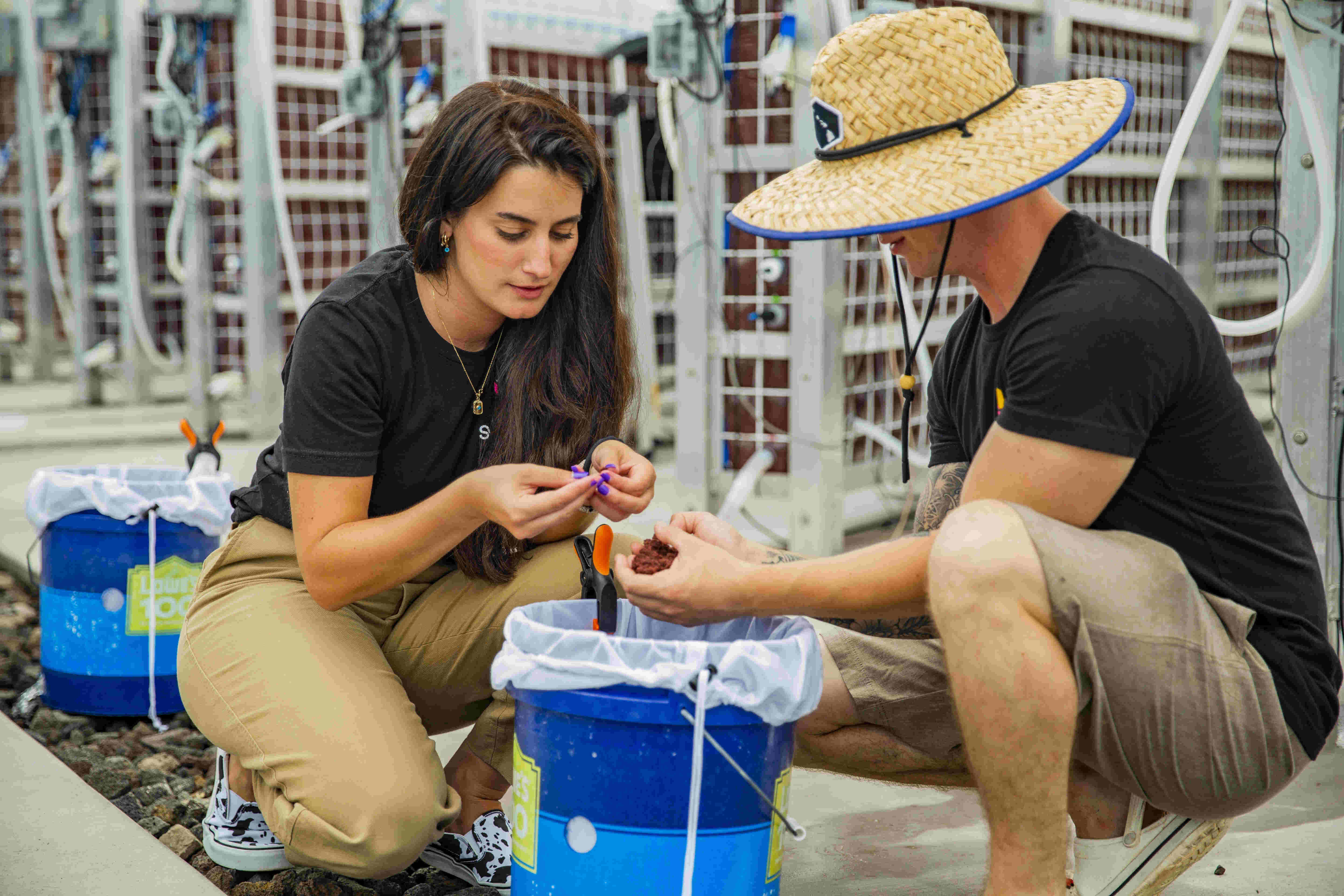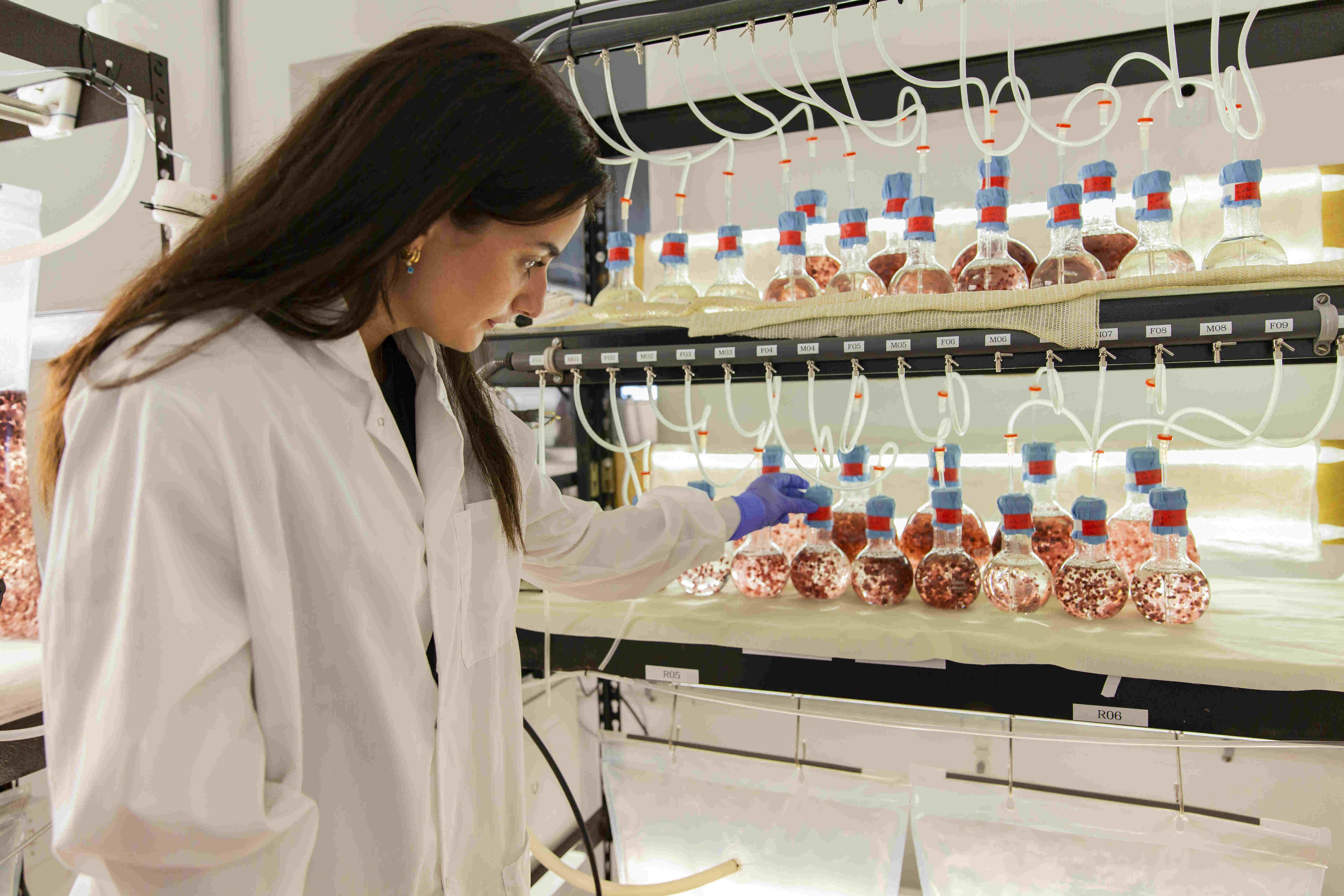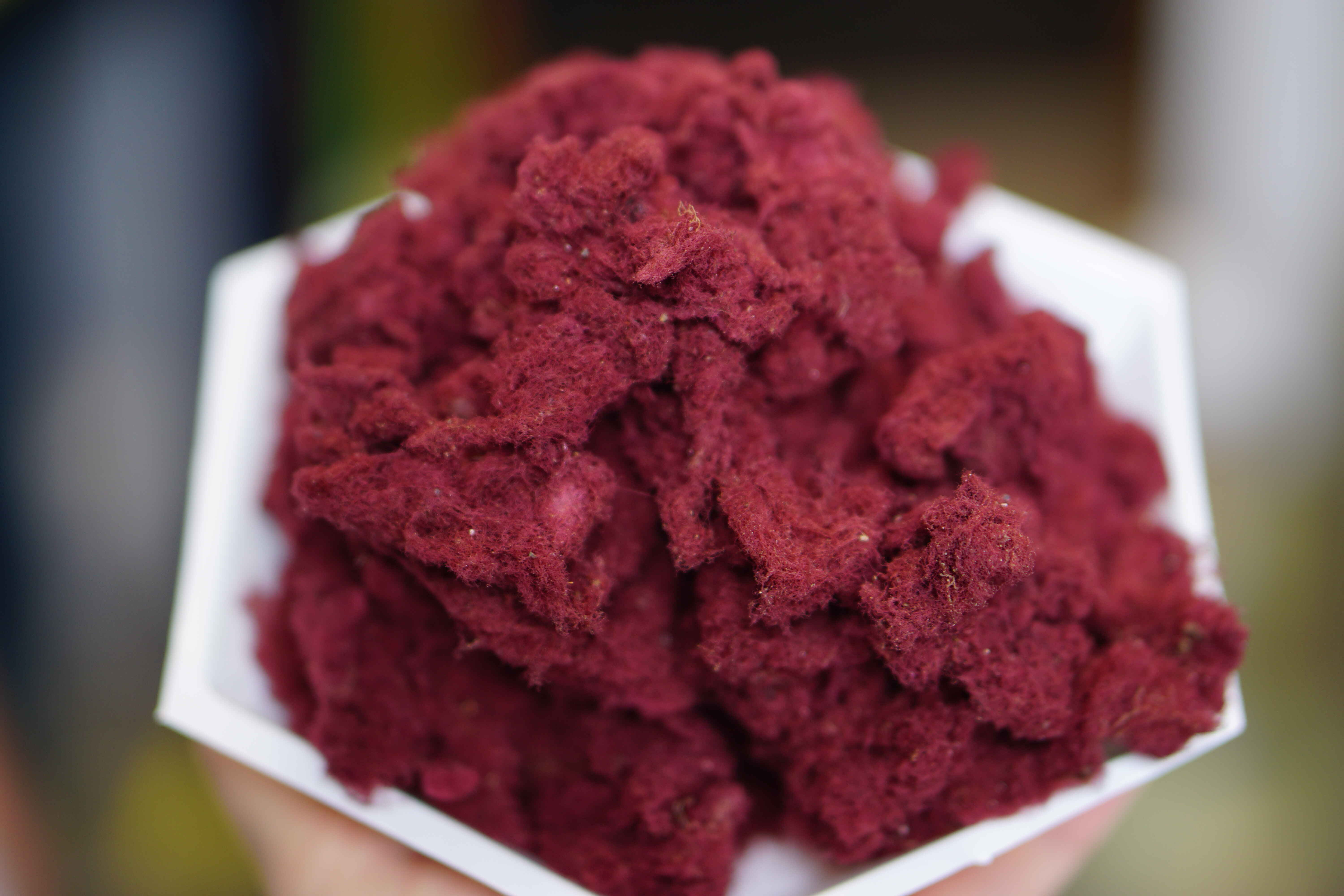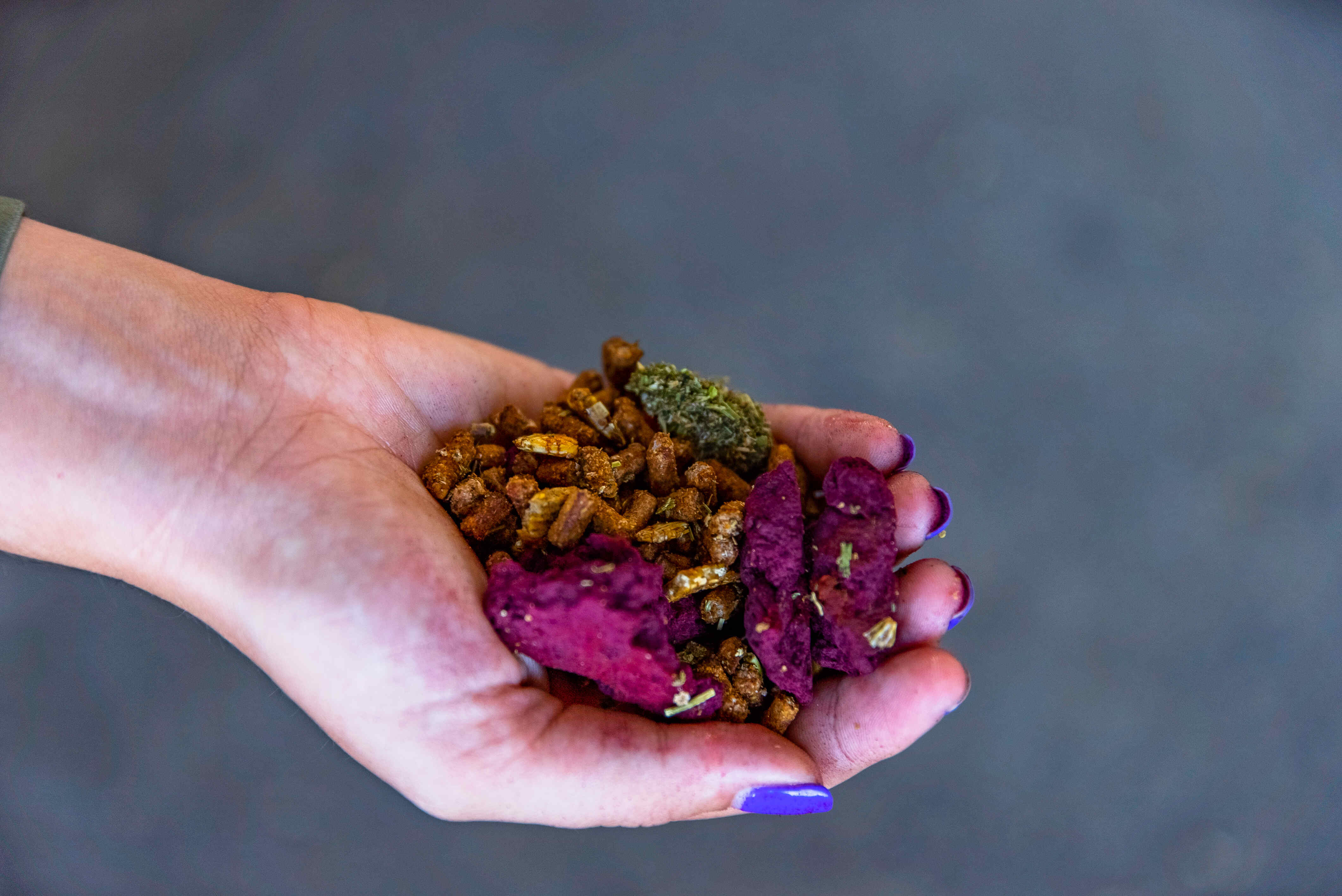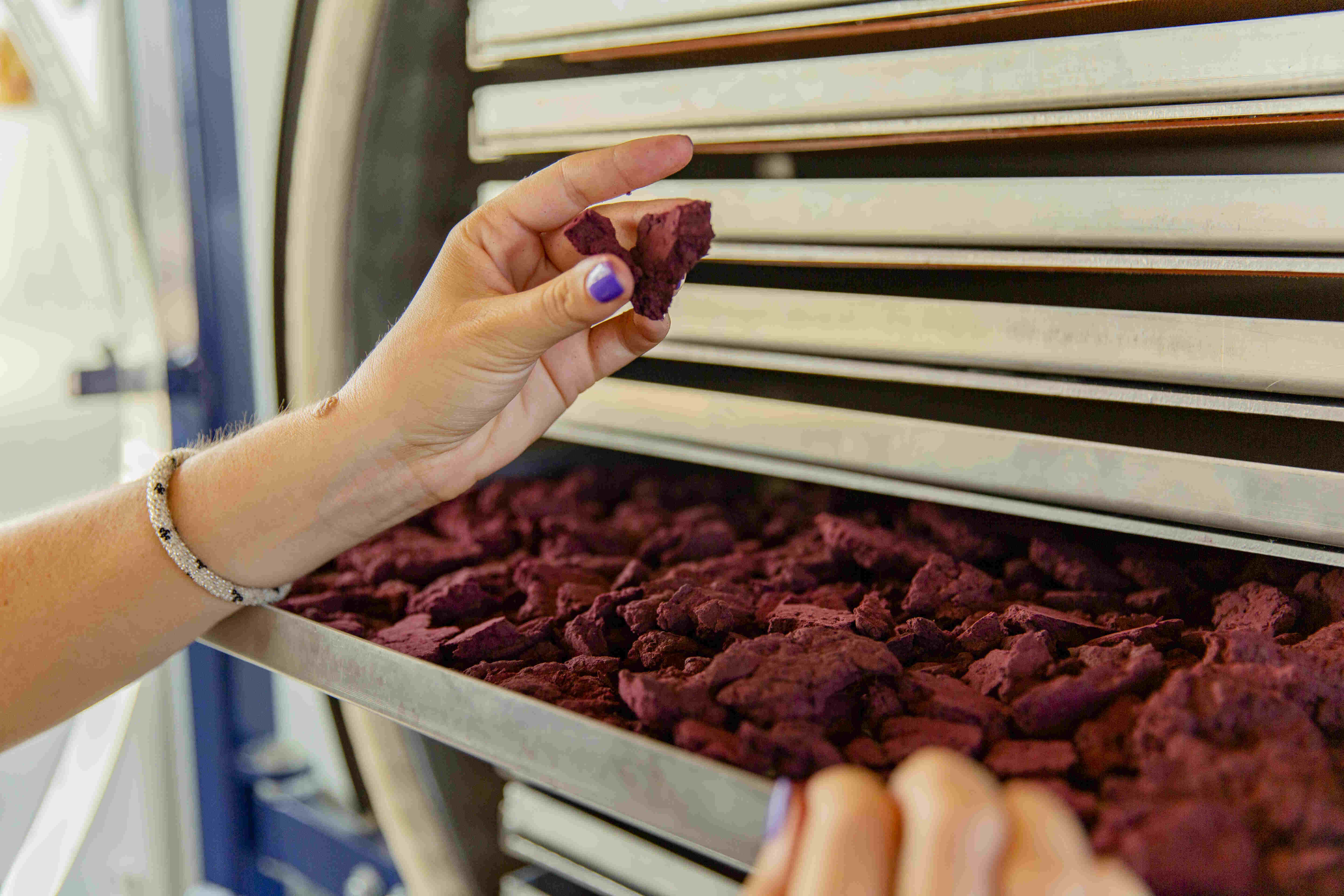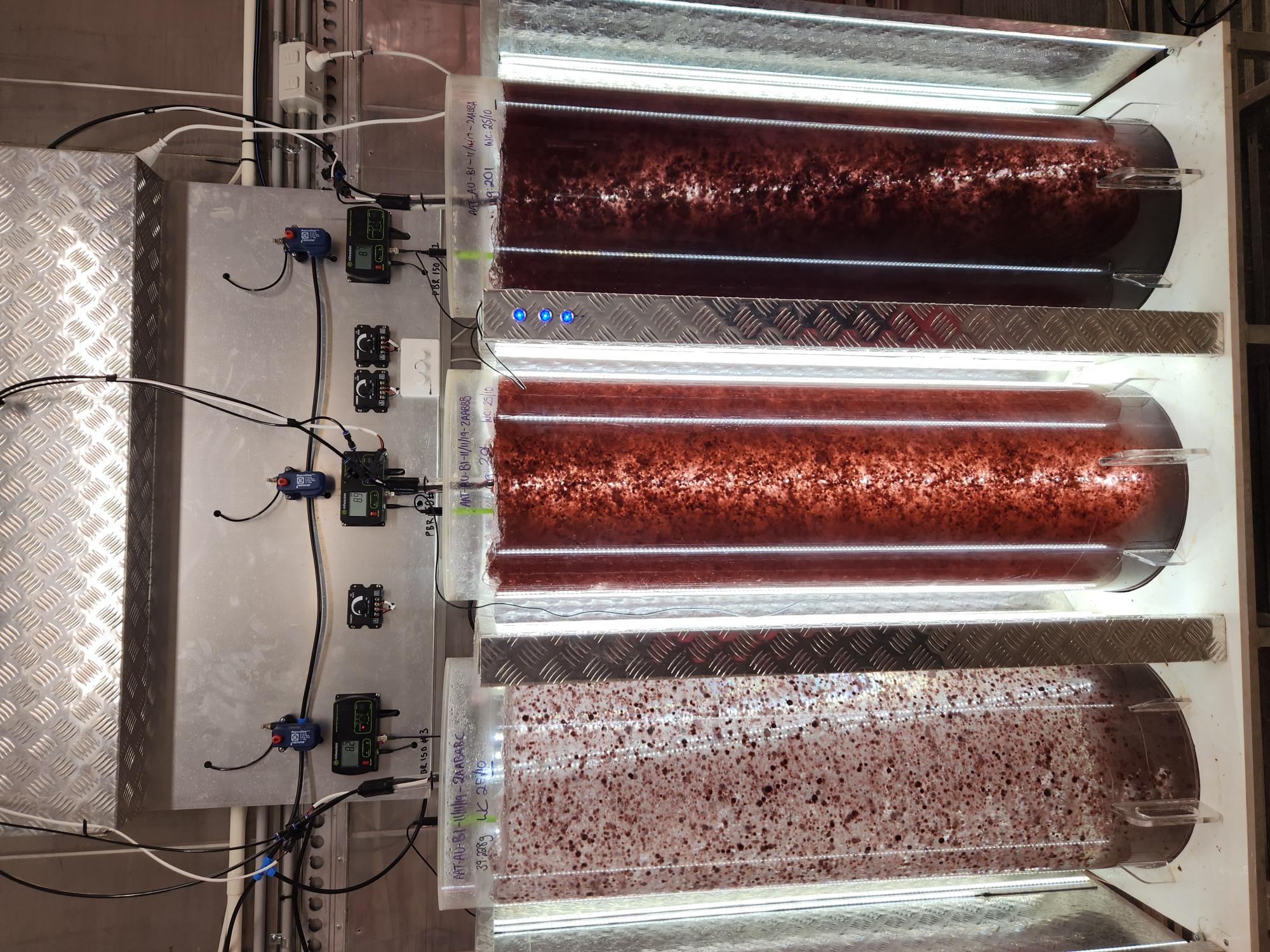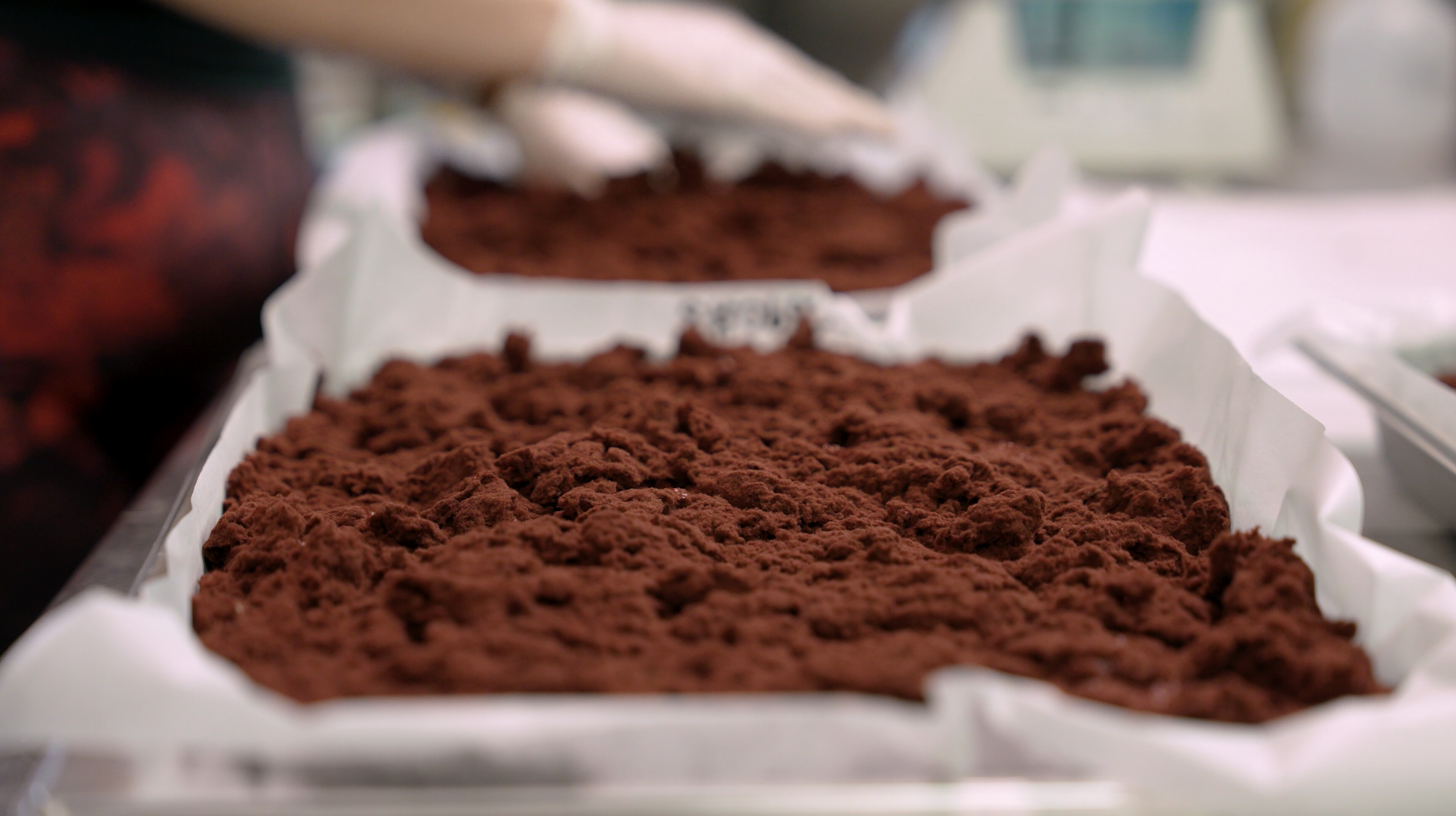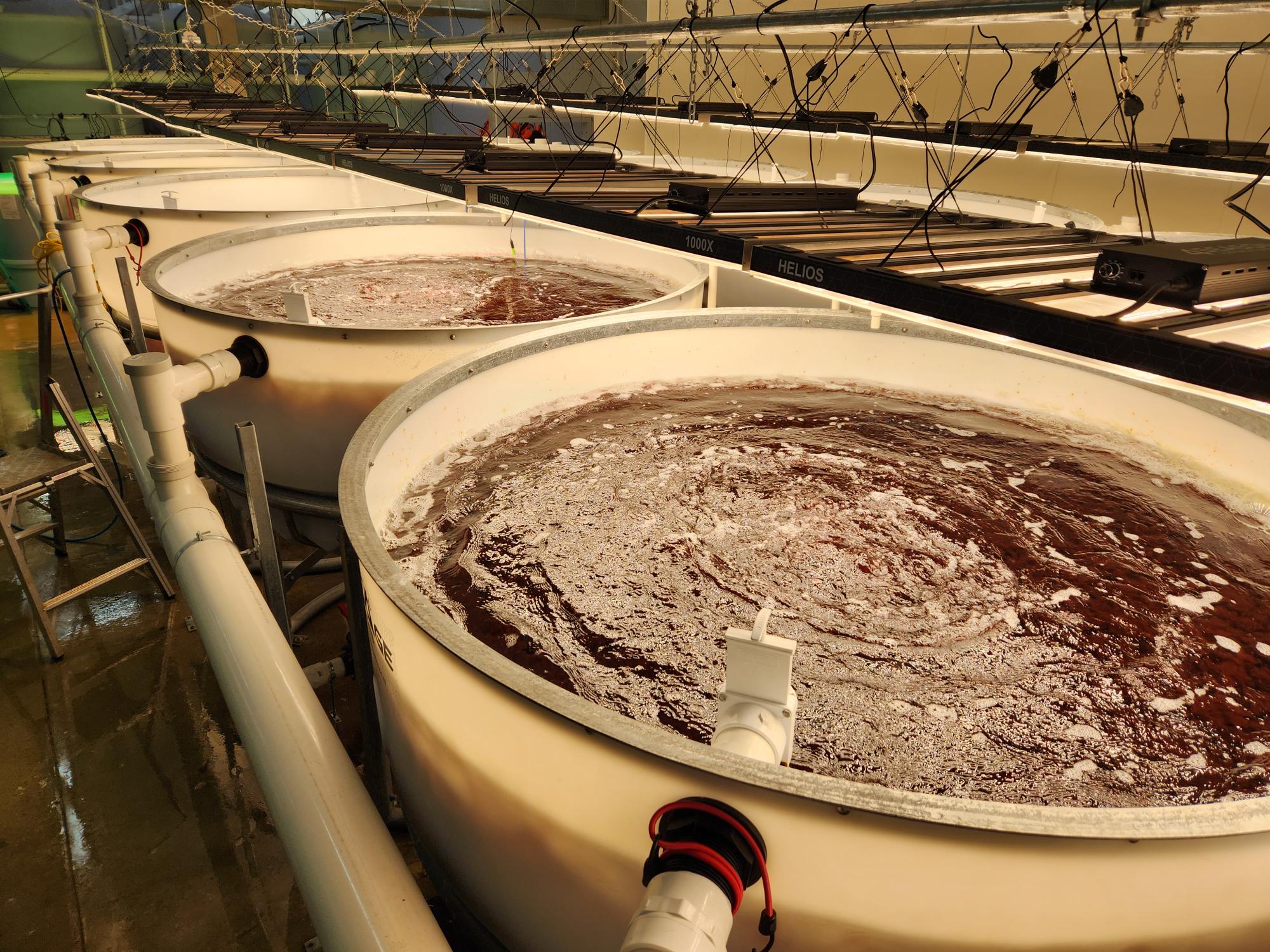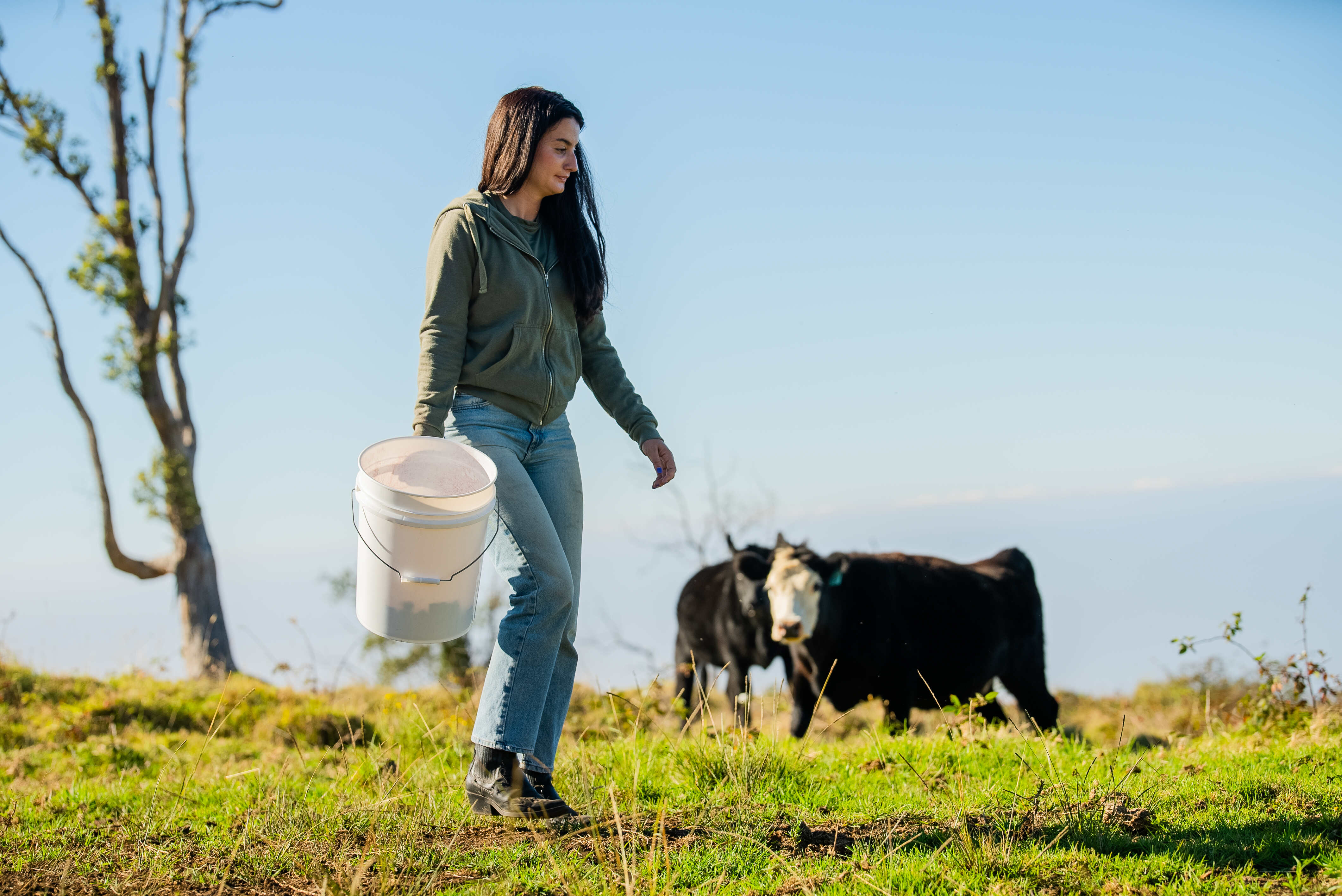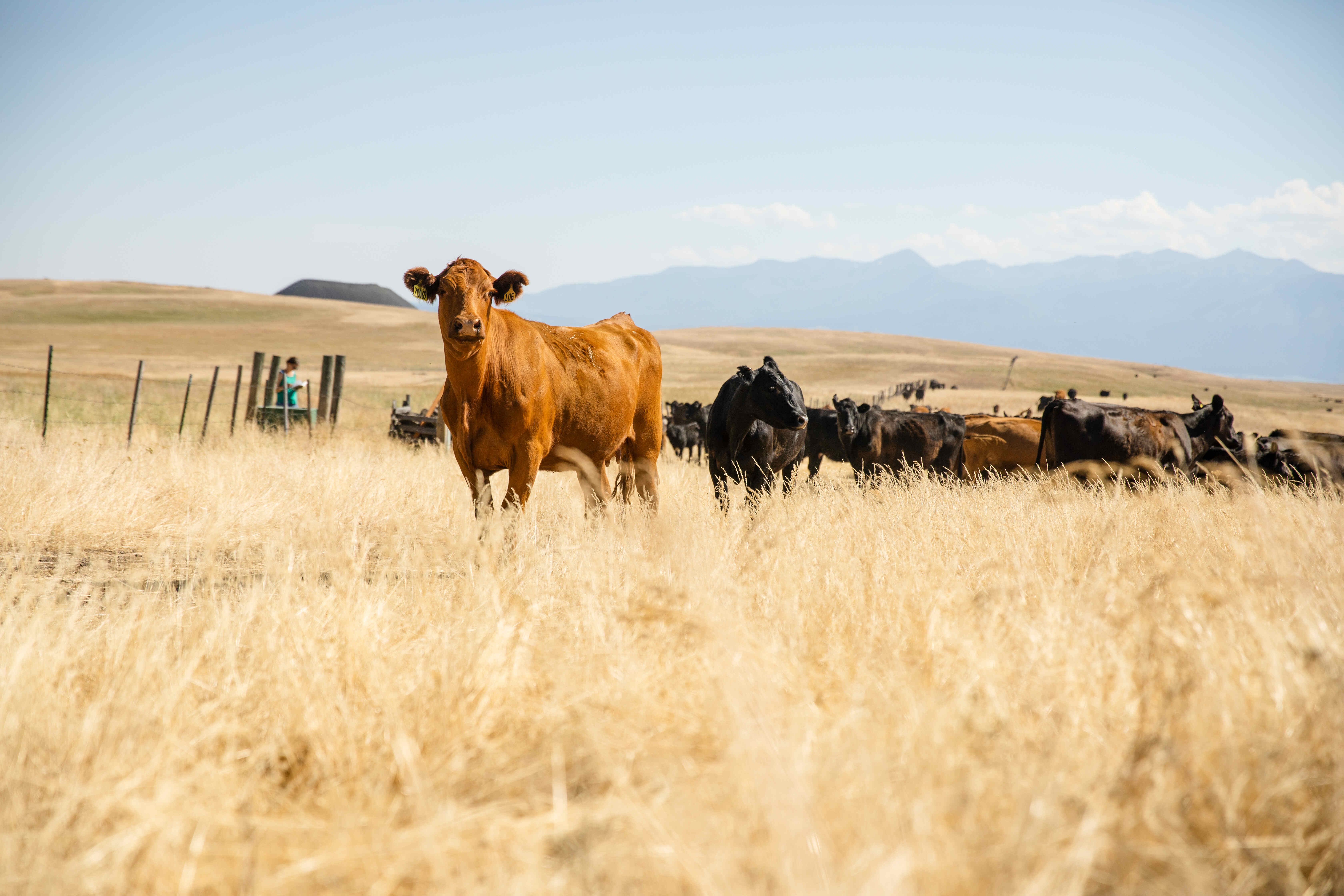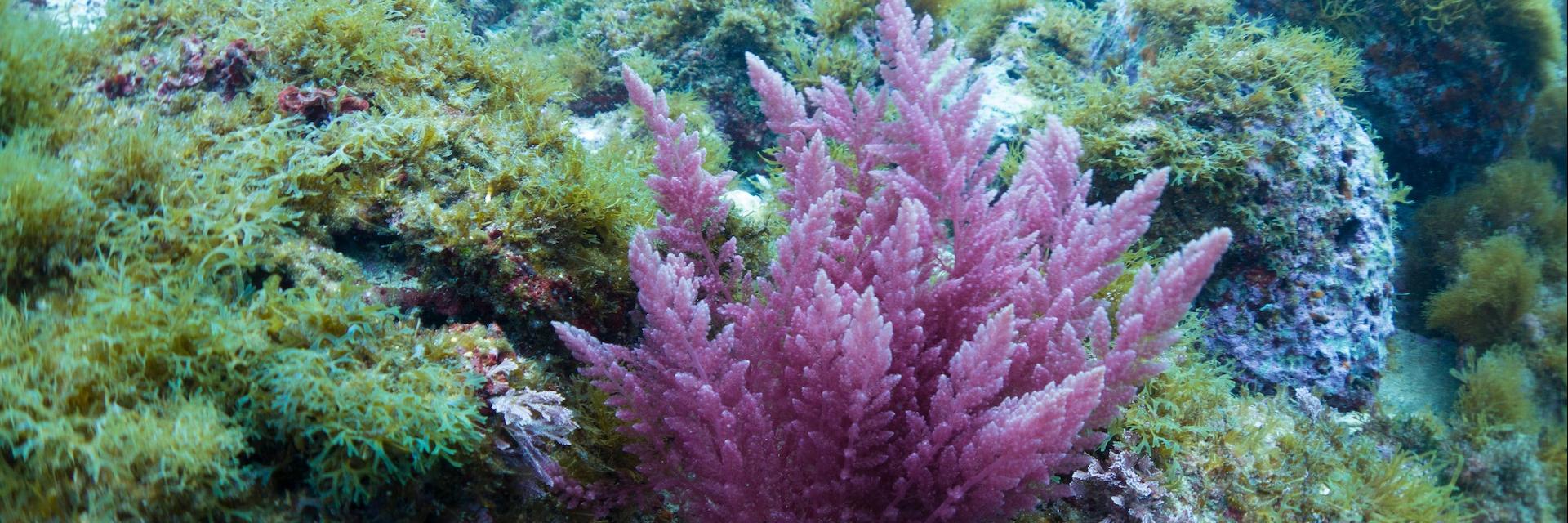
Red algae, Asparagopsis taxiformis, from the Mediterranean, Malta.
Credit: Rasmus Loeth Petersen / Alamy Stock PhotoAsparagopsis
Cultivating a special type of seaweed and feeding it to cattle, sheep, and other grazing animals will greatly reduce methane emissions from livestock.
Methane is responsible for more than a fifth of all the warming we’ve experienced in recent decades. A ton of methane released today will cause eighty-four times as much warming as a ton of CO2 over the next twenty years. Nearly a third of all methane being added to the atmosphere by human activity comes from cattle and other domesticated animals, like sheep and goats, that digest plants in a special stomach called a rumen. Surprisingly, the most promising solution to reducing methane emissions from these domesticated land animals comes from adding a special type of seaweed to livestock feed. Scientists have discovered that a type of red algae in the genus Asparagopsis contains compounds that stop animals with rumens from emitting methane. Recently, scientists discovered that replacing just 0.2 to 1 percent of the diet of these animals with Asparagopsis can reduce their methane production by 80 percent or more. The race is on to develop ways to farm the seaweed on a massive scale, as well as to learn how to process and supply Asparagopsis to farmers and ranchers who often live far from the ocean. Reducing methane emissions from livestock with Asparagopsis feed supplements would have a greater impact on slowing the warming of our planet over the next decade than removing all cars, planes, and ships on Earth.
Action Items
Individuals
Learn about the enormous potential for Asparagopsis in modern agriculture. Methane produced through the process of enteric fermentation in ruminant animals, such as cows and sheep, is not just a climate issue but also a livestock productivity issue. Methane-producing gut bacteria called methanogens rob cattle of up to 12 percent of the energy in their diet. Even before methane’s role in global warming was fully appreciated, ranchers and scientists searched for decades to find an effective feed additive that could curtail the activity of methanogens to speed the growth rates of their livestock. They tested everything from lemongrass to nitrates with only modest success. A major breakthrough occurred when Canadian rancher Joe Durgan and scientist Robin Kinley discovered that Durgan’s cattle were healthier, more fertile, and released 20 percent less methane when fed wild seaweed. Following this discovery, Kinley went back to his home country of Australia to systematically test native seaweeds to find one that would also cut the methane production in the guts of cattle. To his astonishment, a type of red algae called Asparagopsis taxiformis virtually eliminated all methane in laboratory experiments that simulated the conditions of a cow rumen. Further studies have yielded similar results:
- In a subsequent study, Kinley and his team showed that replacing just 0.2 percent of the feed of beef cattle caused a 98 percent reduction in their methane emissions while boosting their growth rates by roughly 50 percent.
- Many other studies in cattle and sheep found a less dramatic but still impressive reduction in methane emissions. A team in California has found a 67 percent reduction in methane by dairy cattle when 1 percent of their diet was replaced by Asparagopsis armata.
- Another group in Australia found up to an 80 percent reduction in methane emissions from sheep when up to 3 percent of their diet consisted of Asparagopsis taxiformis, but the experiment used kiln-dried seaweed, which has lower potency compared to freeze-dried Asparagopsis.
- A more recent and longer-term study by the California team found that switching to A. taxiformis resulted in up to an 80 percent reduction in methane emissions of beef steers over 147 days, even though the seaweed was used to replace only 0.5 percent of their diet.
- To sort through conflicting studies, one group conducted a meta-analysis that examined the findings of many past studies at the same time. The team found that while there was a clear effect of Asparagopsis on reducing methane emissions, the other benefits, such as increased milk or beef production, were only modestly supported by the data.
- Much of the variation in the effectiveness of Asparagopsis in reducing methane emissions in cattle is likely due to varying concentrations of the compound bromoform (also known by its chemical formula, CHBr3), which has been shown to inhibit a key enzyme used by methanogens.
- A scientist working with the University of California, San Diego, and Blue Ocean Barns, is working on ways to manipulate the nutrients used by farmed Asparagopsis. By increasing the amount of bromoform in the seaweed’s tissues, they hope to increase its potency.
- Differences in diets might also explain why some ruminants respond better to Asparagopsis supplements than others. In one study, a high-grain diet in beef steers was associated with an 80 percent decrease in methane, but a diet rich in hay was only associated with a 51.9 percent decrease.
- Asparagopsis can also be used to sop up excess nutrients in marine or aquaculture settings. It has high efficiency as a biofilter in land-based aquaculture, and seaweed farms of various types have shown high potential for helping mitigate the impact of open-water fish pens (see Seaweed Farming Nexus). It is also being explored as a way to filter water from shrimp farms.
- Asparagopsis is especially adept at removing excess nitrogen and phosphorous that can cause harmful algal blooms and marine dead zones. It can also filter out heavy metals like arsenic that wash into the ocean, but then may not be suitable as a feed supplement.
Learn about the hurdles to achieving the full potential of Asparagopsis. Cattle are often ranched far from the coastal waters suitable for Asparagopsis farming. Getting all cattle a steady supply faces the following challenges:
- Farming Asparagopsis requires “closing the life cycle,” or growing it across each of its three life stages, including its largest frond-waving stage in the open ocean. See Seaweed Farming Nexus for more information.
- Most studies so far have come from harvesting wild Asparagopsis, though it appears some of the start-ups are on the cusp of being able to establish large-scale ocean farms.
- Other groups are finding ways to use land-based tanks to mass produce an early stage of Asparagopsis that looks like little free-floating pompoms, which seem to be equally effective at reducing emissions, but can’t be grown in open ocean farms.
- It is not yet clear how Asparagopsis synthesizes its active compound (bromoform) or why the concentration of those compounds can vary by a factor of ten among samples. Some researchers are investigating whether it has to do with the nutrients available to the seaweed. Others are creating “seaweed libraries” to see if Asparagopsis from some regions are better at producing bromoform.
- Bromoform can turn into a gas over time, meaning that cattle need to be fed seaweed that has been harvested relatively recently or has been carefully preserved. This raises logistical challenges, particularly for far-flung and inaccessible cattle ranches. Asparagopsis processors will have to make important investments to ensure they are sending potent products to their farmers.
- Currently, there are three options for processing Asparagopsis. Freeze-drying is very effective at preserving bromoform but is the most expensive. Creating oil immersions with fresh Asparagopsis taxiformis to preserve bromoform compounds in the seaweed can extend its effective shelf life to at least twelve weeks, but is also expensive. Simple kiln drying results in a drop in bromoform and makes it less effective as a feed supplement.
- Most ranchers currently have little incentive to buy Asparagopsis feed instead of traditional feeds. However, if it helps cattle gain weight (or gain the same weight with less feed), as has been found in some studies, farmers may start purchasing Asparagopsis feed additives without additional regulations.
- It’s not yet clear how much Asparagopsis supplement to give and how often to give it. Fortunately, mathematical models may make the process easier and are the subject of ongoing research.
- Some cattle may enjoy eating seaweed more than others, and that seems to affect the degree of methane reduction. Innovation in feeding methods may be necessary to figure out how to present Asparagopsis in a way that cattle will readily consume it regularly in a variety of settings.
- Two suspected hurdles—that the seaweed would affect the taste and/or safety profile of milk—have been dismissed by blind taste tests and laboratory studies.
- Some concerns have been raised about the potential negative effects of Asparagopsis on the stomach linings of some cattle, especially when it is consumed for an extended period.
Buy Asparagopsis-fed animal products. While most commercial Asparagopsis is currently being used in experimental trials, the supply is expected to increase dramatically as many different start-ups expand their operations and the challenges of growing Asparagopsis in farms are solved. Hopefully, it won’t be long before a variety of meat, dairy, and wool products sourced from Asparagopsis-fed animals will hit the market.
- The first commercial product from Asparagopsis-fed animals to be available for purchase will likely be a line of high-end men’s suits from wool distributed by M.J. Bale of Australia, which is working to develop the world’s first Carbon Neutral Wool clothing.
Buy carbon offsets from, invest in, or donate to Asparagopsis growers. One start-up that is currently growing Asparagopsis is selling carbon offsets that let you support their expanding operations. Others are accepting philanthropic donations or soliciting potential investors.
- Symbrosia, a Hawaii-based start-up growing Asparagopsis, offers a variety of carbon-offset plans.
- Sea Forest asks those interested in potential investment opportunities to get in touch and also suggests signing up for their mailing list to hear about them as they develop.
- Greener Grazing encourages the philanthropically minded to get in touch for opportunities to support their work.
Groups
Mariculturists
Become Asparagopsis growers. The techniques and tools for growing Asparagopsis in open ocean seaweed farms are rapidly developing. At least one company is looking to license their know-how to help seaweed farmers switch to Asparagopsis and to help fish farmers incorporate Asparagopsis into their operations.
- Greener Grazing has a contact form that they encourage prospective cultivation partners to use to get in touch.
Ranchers
Partner with an Asparagopsis grower for an experimental trial. Farmers with cattle, buffalo, sheep, or goats can seek partnerships for ongoing trials of Asparagopsis feed additives. Symbrosia has a form that potential partners can fill out here. CH4 Global also encourages farmers to get in touch.
- Sign up for newsletters to stay up to date on Asparagopsis. FutureFeed, Greener Grazing, Blue Ocean Barns, and Sea Forest all have newsletters or email lists that you can sign up for to hear about their latest developments, including new partnership opportunities, products coming to market, and the results of new feeding trials.
Companies
Source meat, dairy, and wool products from Asparagopsis-fed ruminants. Until Asparagopsis farms scale up, low-methane supply chains may require paying a modest premium, but early adopters are also afforded unique branding opportunities.
- M.J. Bale Menswear in Australia supported one of the first commercial trials of an Asparagopsis feed for six hundred Merino sheep. Wool from the sheep was transported using electric vehicles, as part of a campaign to develop the world’s first Carbon Neutral Wool clothing.
- The Hawaii-based company Symbrosia has a contact form for interested U.S. businesses looking to bring Asparagopsis onto their farms.
- Woolworth, the grocery store chain, partnered with FutureFeed to expand their Asparagopsis farming operations. In doing so, they received positive media attention during a FutureFeed steak-tasting event hosted by a celebrity chef as part of Australia’s National Science Week.
Partner with or invest in Asparagopsis producers. Seaweed production is an industry poised for rapid growth. The Australian Sustainable Seaweed Alliance projects that the Asparagopsis industry in Australia alone could be worth $100 million by 2025 and $1 billion by 2040.
- Particularly as the scale of farming Asparagopsis is set to ramp up dramatically, the industry has attracted significant attention from the investment community.
- The New Zealand dairy giant Fonterra registered the trademark Kowbucha™ for a planned cattle-feed additive, which they are working on thanks to their partnership with the Asparagopsis-grower Sea Forest.
- Last year in Tasmania, Sea Forest reportedly had no trouble raising AUS$50 million in capital from investors who were eager to see the company start producing its promised 7,000 tons of Asparagopsis a year from its 1,800-hectare lease of coastal waters north of Hobart.
- Pirie Meats in Australia has signed an offtake agreement with CH4 Global to supply its seaweed supplement for Pirie’s ten thousand head of cattle.
Develop Asparagopsis carbon offsets. There is currently little financial incentive to adopt Asparagopsis supplements to reduce methane emissions in livestock. Methane reductions from Asparagopsis could be quantified and serve as real, fast-acting carbon offsets or onsets (See Offsets Nexus and Onsets Nexus).
- Symbrosia is the only company that currently offers carbon offset plans for businesses by directly supporting farmers. Other third-party companies could develop transparent, measureable carbon offsets that would make Asparagopsis supplements more affordable or even lead to payments to ranchers.
Governance
Create financial or regulatory incentives to decrease methane emissions. Currently, the agricultural companies responsible for the emission of methane from ruminants in much of the world do not have clear incentives to reduce their emissions without disadvantaging themselves against competitors. A variety of policy mechanisms could change the status quo.
- The single most important piece of legislation for Asparagopsis that has been adopted in the United States is a state law in California that requires a 40 percent reduction below 2013 methane levels by 2030. While the specifics of the regulations were meant to target methane emissions from cow waste, the targets can be met by reducing methane from cow burps, creating a financial incentive to utilize Asparagopsis-based feed rather than installing expensive machinery called digesters.
- In September 2021, the U.S., the EU, and seven other countries announced the Global Methane Pledge ahead of the COP26 UN climate conference. The pledge is a commitment to reducing methane emissions by 30 percent below 2020 levels by the year 2030 and would prevent 0.2°C of warming by 2050. Achieving this goal will be nearly impossible without reductions in methane emissions from livestock, adding top-down pressure to accelerate the deployment of innovations like Asparagopsis feed additives.
Support research institutes and small businesses working on Asparagopsis. Grant programs like National Science Foundation’s Small Business Innovation Research, which have provided funding to Asparagopsis growers and early adopters, should be expanded.
- Grants from government agencies like the NSF have been important for funding research efforts by Asparagopsis companies.
Streamline the regulatory hurdles for Asparagopsis. Regulators can ensure that proving the safety and efficacy of Asparagopsis feed additives is a high priority and done with as little red tape as possible.
- The U.S. Food and Drug Administration (FDA) does not allow the use of seaweed in livestock diets except for certain species, for certain uses, and at certain inclusion rates. Getting approval for Asparagopsis use in the U.S. will require expensive, complicated, and time-consuming commercial trials.
- The FDA has already spent four years reviewing the application for a non-Asparagopsis methane-reducing feed additive called 3-NOP (and its trade name, Bovaer, by its Dutch manufacturer Royal DSM), and will likely spend additional years reviewing it. Less effective than Asparagopsis at reducing methane emissions, 3-NOP has already been approved in Brazil and Chile for use in cattle, sheep, and goats.
- It takes the U.S. FDA seven years on average to review new animal drugs, an unacceptably long delay given the urgency of the global climate crisis. Potential workarounds include an interim emergency use authorization or ensuring that Asparagopsis gets regulated as an animal feed, rather than an animal drug. Another option is to copy European regulators and establish an expedited review process for what they deem “additives favorably affecting the environmental consequences of animal production.”
Key Players
Research Institutions
Commonwealth Scientific and Industrial Research Organisation (more commonly, CSIRO) is an Australian government agency tasked with many different types of scientific research in the public interest. They supported the research that initially discovered the potential of Asparagopsis as a methane reducer for ruminants. They are also part of the FutureFeed initiative.
The University of California, Davis Animal Nutrition & Environment Modeling Applications Laboratory (ANEMAL) has hosted much of the published research on Asparagopsis feeding trials in the U.S., led by Prof. Ermias Kebreab.
CleanEyre Global (Prince Edward Island, Canada) researches the most effective and sustainable way to bring Asparagopsis to ranchers.
Start-ups
Symbrosia is a Hawai’i-based cleantech startup founded and led by Alexia Akbay that cultivates fast-growing seaweed strains and develops them into high-value products. Symbrosia has developed SeaGraze™, a natural seaweed feed additive that drastically reduces livestock methane emissions. Called “the seaweed that could save the planet” by The Verge, Forbes, and Inc. Magazine, SeaGraze™ is setting a new standard for sustainability in the U.S. beef, dairy, and apparel industries. In June 2022, Symbrosia raised a $7 million funding round led by Danone Manifesto Ventures. The company is on track to create new solutions and products for sustainable farming strategies in 2024.
FutureFeed is an Australian-based Asparagopsis grower and processor that was born of an intellectual property partnership involving CSIRO, scientist Rob Kinley, and Meat and Livestock Australia (i.e., many of the key players that made the initial discovery of the role Asparagopsis taxiformis can play in reducing methane emissions from cattle). Their planned feed products are hotly anticipated by farmers in Australia.
Sea Forest is a Tasmanian company that has begun producing Asparagopsis for their partners Fonterra, an international dairy giant, and M.J. Bale, which sources wool from the region for high end men’s suits. After easily raising $50 million in capital investments, they are poised to become the largest seaweed growers in the southern hemisphere.
Blue Ocean Barns is an Asparagopsis-growing, public-benefit company founded by Joan Salwen and Matt Rothe, that is building on Salwen’s work at Elm Innovations, a Stanford-based nonprofit founded by Salwen.
Greener Grazing is an offshoot of Australis Aquaculture, a company that started as a fish-farming organization. The initiative is focused on scaling up production of Asparagopsis through innovation in breeding and cultivation of the seaweed. They established the world’s first seed bank of Asparagopsis taxiformis strains from more than thirty sites across its native range.
CH4 Global is a new venture based in Australia and New Zealand that, with a sense of urgency, is building capacity to grow Asparagopsis. They recently announced $13 million in Series A funding.
Volta Greentech, a Sweden-based start-up, produces Volta Seaweed, a 100-gram-a-day Asparagopsis supplement for cattle.
Individuals
Alexia Akbay, founder and CEO of Symbrosia, an innovative and prominent player in the cultivation and testing of Asparagopsis.
Rob Kinley, chief scientist at FutureFeed and the discoverer of the methane-reducing potential of Asparagopsis taxiformis.
Ermias Kebreab, professor and director of the UC Davis World Food Center. His research on greenhouse gas emissions from agriculture includes studies on the effects of Asparagopsis on methane emissions in cattle.
Joan Salwen, cofounder and CEO of Blue Ocean Barns, another Hawaii-based company working on Asparagopsis farming. The company was founded as a commercial engine for the Stanford-based nonprofit Elm Innovations, which Salwen also founded to explore seaweed as a solution to climate change.
Joe Durgan, rancher and co-owner of NAO Organics, which produces methane-reducing cattle feed from (non-Asparagopsis) seaweeds on Prince Edward Island. His research on the benefits of seaweed for cattle in Canada led to the discovery in Australia of the properties of Asparagopsis.
Learn
Watch
WAR ON COW BURPS: Can Scientists Help California Produce Less Methane? by NBC Left Field (13 mins.)
Scientists Created This Seaweed to Save the Planet by The Verge (9 mins.)
An Unusual Snack for Cows, A Powerful Fix for Climate by The Washington Post (2 mins.)
How Seaweed Could Slow Down Climate Change by Seeker (8 mins.)
Trial Update: Surf, Turf & Carbon Neutral Wool by M.J. Bale (3 mins.)
Greener Grazing: A Seaweed Solution to Reduce Methane Emissions from Livestock by Greener Grazing (3 mins.)
Can Seaweed Save the World from Livestock Emissions? by FT Food Revolution (5 mins.)
This seaweed can fight climate change by Verge Science (9 mins.)
Read
"There’s a Simple Fix for the Emissions in Cow’s Burps: Just Give Them a Little Seaweed" by Adele Peters / Fast Company
“Kowbucha, Seaweed, Vaccines: The Race to Reduce Cows’ Methane Emissions” by The Guardian
"Cows and Climate Change: Making cattle more sustainable" by Amy Quinton / UC Davis
"Methane emissions are driving climate change. Here’s how to reduce them." by United Nations Environment Program
"How Eating Seaweed Can Help Cows to Belch Less Methane" by Judith Lewis Mernit / Yale Environment 360
"Seaweed Could Make Cows Burp Less Methane and Cut Their Carbon Hoofprint" by James Temple / MIT Technology Review
"Feeding Cows Seaweed Could Solve The Big Bovine Burp Problem" by Nichole Kobie / Wired
“Cows Make Climate Change Worse. Could Seaweed Help?” by Jon Emont / Wall Street Journal
"Big Guns Pile into Seaweed for Green Cattle" by Brad Thompson / Financial Review
“Key Considerations for the Use of Seaweed to Reduce Enteric Methane Emissions From Cattle” Vijn et al. / Frontiers in Veterinary Medicine
"Study: Seaweed in Cow Feed Reduces Methane Emissions Almost Entirely" by Zoya Teirstein / Food Tank
"Seaweed Company Closing In On Commercial Feed To Reduce Livestock Emissions" by Shan Woodwin / Farmonline
"Methane Reduction Trial Work Continues at FutureFeed" by Gregor Heard / Farmonline
Listen
Emission Control by Reveal Podcast (54 mins.)
In First Real-World Experiment, Red Seaweed Cuts Methane in Cows by More Than Half by Science Friday (11 mins.)
39 Ways to Save the Planet: Cutting the Cow Burps by The BBC (13 mins.)
Seaweed FTW with Farmer Joe Dorgan by Food Stuffs Podcast (24 mins.)
Steve Meller, CH4Global CEO by The Business of Aquaculture Podcast (17 mins.)
Share this page


